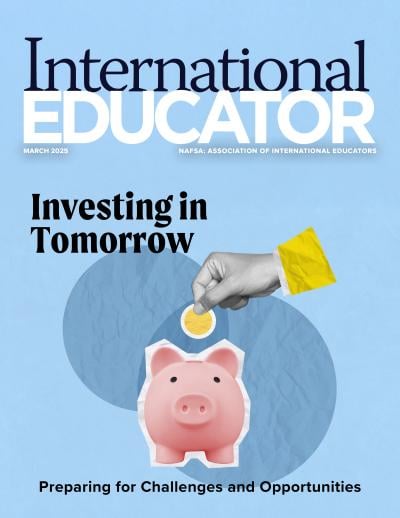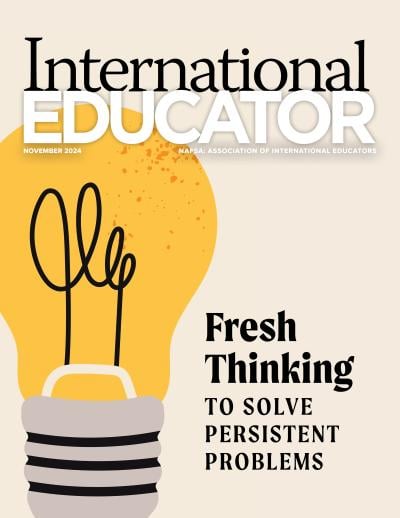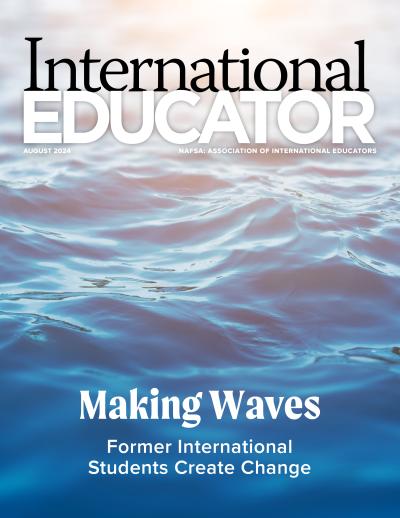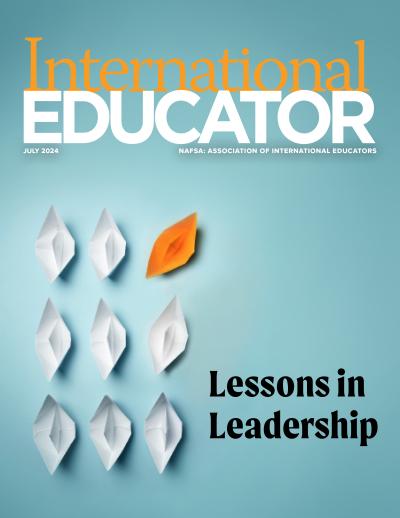Full-Spectrum Risk Management
Susan Roberts jokingly says her office’s risk manager is “paid to worry.”
“He worries really well—always thinking of a million things that could go wrong,” says Roberts, associate provost for internationalization at the University of Kentucky.
For senior international officers (SIOs) and other international education leaders, the tasks of risk management include applying a more strategic bent to the many potential crises that could arise, coordinating with university-wide risk management structures, and developing policies and protocols to respond to specific issues.
Risk management is a growing part of all institutional activities, and it poses additional challenges for international offices and their programs. “I often reflect that we have 15,000 students who live [on campus], but if you were asked [to] account for 100 percent of residential students in 24 hours, people would just laugh,” says Mark Eckman, executive director of global education at the University of Massachusetts-Amherst (UMass Amherst), “whereas we’re expected to be able to account for the whereabouts and well-being of students anywhere on the planet.”
Most international offices have spent decades developing procedures and nurturing partnerships to ensure support for students and faculty enmeshed in crises far from home. However, the volatility around the world in recent years is exacerbating long-standing challenges in risk and crisis management.
“The reality is, if we’re going to have an international program with students in diverse parts of the globe embedded in global communities—all the things we want from an international education standpoint—how much risk we are willing to take is the calculus we have to make.” —Cheryl Matherly
“We’re in an era when assessing and managing risk is quite difficult because things are less predictable,” Roberts says. “It’s harder to manage risk when it’s a volatile world, so you have to recalibrate.”
That recalibration must be done within and beyond the international office. “It’s a given that we all want to work in the best interest of the university and our students,” says Cheryl Matherly, vice president and vice provost for international affairs at Lehigh University. “The reality is, if we’re going to have an international program with students in diverse parts of the globe embedded in global communities—all the things we want from an international education standpoint—how much risk we are willing to take is the calculus we have to make.”
Solving a Complex Calculus Problem
At the University of Colorado-Denver (CU Denver) Anschutz Medical Campus, international efforts represent slightly less than 10 percent of campus activities. “However, serious international incidents can quickly become top university priorities,” says Alana Jones, associate vice chancellor for international affairs.
International offices must plan for a wide range of contingencies—“anything from someone’s flight having a problem to something really tragic,” Roberts says. Comprehensive risk management must cover all areas of international education, from study abroad to international student recruitment and enrollment, international student and scholar services, faculty research, and more—all of which have different challenges. Ensuring institutional alignment requires the international office to work with many departments and stakeholders, from legal and procurement offices to campus safety, health, and student affairs, as well as institution-wide risk management and crisis response committees.
“Everything we do is part of the larger university risk management practice,” Matherly says. “My role is keeping an eye on managing those parts that fall into the international space and portfolio.”
“You can’t eliminate every risk [because] you can’t know where they’re coming from.” —Sonia Feigenbaum
Refining risk management for this changing calculus requires a full-spectrum approach. Leaders must ensure institutional alignment, develop policies and procedures, continuously assess evolving risks, and provide training within and beyond their offices. Implicit in these strategies are a variety of essential skills, including relationship building, communication, and the ability to recognize that crises will always occur.
“You can’t eliminate every risk [because] you can’t know where they’re coming from,” says Sonia Feigenbaum, senior vice president for global engagement and chief international officer at the University of Texas-Austin (UT Austin). “What you need to have in place is robust communication and policies that will allow you to take on everything that comes your way.”
Seeking Institution-Level Alignment
As with other international office initiatives, risk management strategies should align with the institutional strategic plan—but that’s just the first step, according to Jones.
“It is my responsibility to proactively outline and communicate this alignment to senior leaders…and to ensure leaders understand the international risk management policies and processes in place and have a level of confidence in those frameworks and our ability to respond to international incidents,” she says.
Given the unique risk profile of international activities, SIOs must also have a sense of what level of risk institutional leaders consider appropriate. “Don’t assume you know the institutional risk tolerance or the expectations of your leadership without specific communication on this topic,” Jones adds. “It is important to have intentional conversations about risk tolerance and expectations with your leadership. When there are senior leadership transitions, new conversations are necessary.”
“Don’t assume you know the institutional risk tolerance or the expectations of your leadership without specific communication on this topic.” —Alana Jones
Leaders must also navigate similar dynamics with their counterparts who sit on university-level risk management committees and participate in other leadership structures. These groups often focus on issues involving student life, athletics, and campus safety—and without an international leader’s active participation, the groups may not navigate the nuances of risk involved in overseas activities as readily as you’d hope.
At Lehigh, for example, students are involved in fieldwork in several remote parts of the world with the support of regional nongovernmental organizations. The university typically requires such organizations to have a set level of insurance, but that isn’t realistic in some regions, according to Matherly.
“We’re taking that risk because we know there’s no other way we’re going to be able to have undergraduate students working in the field,” she says.
In some cases, these conversations extend beyond campus to the system level. At CU Denver Anschutz, members of the CU system risk management committee sit on the Anschutz Medical Campus international risk management committee, while in Maine, six state institutions collaborate with a system-level risk management office, as Orlina Boteva, director of the Office of International Programs at the University of Maine, explains.
System-level structures can help reinforce alignment and provide extra support. Such organization “allows us to have a broader group of colleagues we can meet with and discuss, along with a lot of protocols for decision-making and a really good information flow that allows us to evaluate and prepare to respond,” Boteva says.
Developing Policies and Procedures
Protocols and response plans can bridge high-level risk management with preparation for specific incidents. They also can help guide expectations, particularly among staff who will be the first responders in any crises. “The key is having really good policies and procedures in place that people understand,” Roberts says. Strategies include the following:
Ensure procedures cover the full spectrum of risk management.
The Enterprise Risk Management (ERM) methodology provides a framework for ensuring all bases are covered, from preparation and response to ongoing monitoring of potential risks (see “The ABCs of ERM”).
While preparation involves many steps, including travelers in this work is an often underappreciated one. At UT Austin, Texas Global considers predeparture workshops and orientations for both education abroad and international students and scholars a key part of risk management preparation. Safety information and resources are shared during these activities, according to Feigenbaum. “We touch upon every aspect of what it looks like to be preparing for travel,” she says.
Strike a balance between procedures and flexibility.
The past five years highlight the importance of being agile enough to respond to unanticipated events, according to Boteva. “Risk management has to be applied so faculty and staff can follow a protocol that is clear and transparent, but nimble enough so that when something like the pandemic comes along, we can quickly change and meet [people’s] needs,” she says.
Deepen relationships beyond reporting responsibilities.
When decisions must be made collaboratively, “you’re making some hard choices, [and] the partners who are part of that consultation need to have been involved enough in all of our international programs that they come at it from the perspective of what the purpose of having an international education program is all about,” Matherly says.
Strong relationships also can help leaders understand the level of concern raised by risk management professionals and other institutional leaders, according to Roberts. “The best solution is to talk it out,” she says.
Never sit on news.
It’s essential to be proactive about communicating to institutional leaders. For example, “a bomb goes off and your students are in that country,” Roberts says. “We [in the international office] know our students are 300 miles from where [the bomb] was, and we understand a little about the politics and the partners on the ground. Who doesn’t know this are the provosts and presidents and vice presidents”—and they are the ones most likely to get calls from concerned faculty and parents, as well as the media.
“Supplying the specifics early on is key. Never sit on news. Even if we have no one in a country, I still try to be proactive and communicate the situation.” —Sue Roberts
As a result, international office leaders must alert institutional leaders about such incidents before they get questions from others. “Supplying the specifics early on is key,” Roberts says. “Never sit on news. Even if we have no one in a country, I still try to be proactive and communicate the situation.”
Don’t panic.
When crises emerge, fall back on the procedures and relationships you’ve developed. “We have a lot of tools to assess,” Roberts says. “That lets you get your arms around [the situation].”
The ABCs of ERM
Enterprise Risk Management (ERM) is a framework for approaching risk management from an institutional perspective—both as a general principle and as a specific methodology that outlines best practices.
“ERM methodology for international activities is essential,” says Alana Jones, associate vice chancellor for international affairs at the University of Colorado-Denver (CU Denver) Anschutz Medical Campus—so essential, in fact, that many senior international leaders follow its principles even if they aren’t aware of the formal methodology.
At the highest level, ERM follows a continuous improvement approach, offering best practices for identifying, assessing, responding to, monitoring, and communicating risks, as well as updating policies and protocols as needed or when new risks emerge. ERM also provides a mechanism to connect high-level principles to operational plans for specific crises. At CU Denver Anschutz, for example, “the high-level international risk management strategic planning sets the overall direction; identifies high-level risks and trends; and ensures alignment with the university’s strategic goals, vision, mission, and values,” Jones says. “The practical planning applies the ERM best practices to the specific international activities that deliver on the international education goals and objectives.”
Assessing—and Reassessing—Risk Exposure
Conversations about risk in international programs should focus on “what is realistic that takes into account our responsibility to the institution, the participants, and the nature of the educational experience,” Matherly says.
One way to reinforce the unique nature of those experiences is to involve other partners across the institution in international activities so “they see what you’re doing in action,” she adds.
“A general counsel may only see the contracts and liability waivers you’re dealing with,” Matherly says. “Having those individuals meet [students], read reports, and see the work faculty are involved in makes for a richer conversation, and one that’s easier to have.”
Matherly and her fellow professionals recommend other strategies as well:
Differentiate levels of risk.
There are generally greater expectations of duty of care for undergraduate students than for graduate students and faculty. “In either case, you’re weighing the educational value against the risk and exposure to the institution,” Matherly says.
It’s vital to translate those differing expectations into messaging, rubrics, and other decision-making structures, Eckman notes.
Support international activities outside of the office’s purview.
Even when faculty travel isn’t an explicit part of their responsibilities, SIOs are regularly consulted on this topic at many institutions. However, other departments and staff members may also support programs that span international borders. For example, noncredit student groups or clubs planning international trips may work with student affairs or other departments that are not as versed in the potential risks, according to Boteva.
Build relationships beyond the risk management org chart.
Along with participating in campuswide risk management committees, professionals in the international office should build relationships with key campus collaborators and partners, ranging from on-campus health, housing, and faculty supports to communication and public safety departments.
“I’m not the expert in mental health or how we might work with a student moving back to campus in midsemester, but I don’t need to be, because I can pick up the phone,” Eckman says. “Building and maintaining those relationships are really important.”
Continuously Training—and Evolving
Developing risk management strategies and procedures is an ongoing process, according to Feigenbaum. “It’s filled with trial and error and learning moments,” she says. “I’ve been here six years, and it’s evolved over time.” SIOs recommend several approaches for ongoing training:
Train internal staff and cross-campus counterparts.
Training efforts should go “above and beyond,” Feigenbaum says. “You have to train your entire team for all populations across campus.”
At CU Denver Anschutz, the international risk management committee has developed a protocol for serious incidents. Included as an appendix to the overall campus emergency management plan, the protocol guides training for the committee and also informs ongoing work with the campus emergency response team to ensure the correct supports are in place, Jones says.
Create training structures before—and after—incidents arise.
Most offices and institutional risk management teams plan tabletop exercises in which key players work through hypothetical—but likely—crisis scenarios. At UMass Amherst, for example, the risk management committee meets yearly for tabletop exercises hosted by its broker “to strength-test our systems,” Eckman says. Last year, the committee mapped out a response to a fictional terror attack in a European capital city train station that impacted a faculty-led student group from the university.
Some things we may be dealing with on campus may need to take into account people’s differing immigration statuses.” —Cheryl Matherly
“It was complex, quite messy, and really realistic,” Eckman says. In similar fashion, after-action reviews of actual incidents can help your office identify ways to improve if all stakeholders participate in the exercise.
Planning activities also can help build an understanding beyond the international office. At Lehigh, the university-wide crisis management team often works through tabletop scenarios involving campus incidents; Matherly points out ways these incidents could potentially impact international students. “Some things we may be dealing with on campus may need to take into account people’s differing immigration statuses,” she says. “It’s not the primary thing, but it ends up being part of the discussion.”
Seek support from peers at other institutions.
Boteva meets monthly with education abroad leaders at other land-grant New England universities to discuss a wide range of topics, including risk management. “It’s an amazing resource to talk to colleagues in a confidential space and share crisis situations, protocols, documentation, policies, and resources,” she says. “It helps benchmark how we do things.”
It’s important to collaborate with counterparts with similar roles, according to Feigenbaum. “When there are geopolitical situations that are very fluid, I personally am in touch with other SIOs, while legal affairs and my team are in touch with their peers,” she says.
In the end, these strategies can help avoid worst-case scenarios—some predictable, others completely unanticipated. “The what-ifs are plentiful,” Roberts says. “Having processes, procedures, and policies that everybody understands prevents a lot of confusion and poor communication and allows for a much better response to any kind of unfortunate situation.” •
NAFSA Resources
Additional Resources
About International Educator
International Educator is NAFSA’s flagship publication and has been published continually since 1990. As a record of the association and the field of international education, IE includes articles on a variety of topics, trends, and issues facing NAFSA members and their work.
From in-depth features to interviews with thought leaders and columns tailored to NAFSA’s knowledge communities, IE provides must-read context and analysis to those working around the globe to advance international education and exchange.
About NAFSA
NAFSA: Association of International Educators is the world's largest nonprofit association dedicated to international education and exchange. NAFSA serves the needs of more than 10,000 members and international educators worldwide at more than 3,500 institutions, in over 150 countries.
NAFSA membership provides you with unmatched access to best-in-class programs, critical updates, and resources to professionalize your practice. Members gain unrivaled opportunities to partner with experienced international education leaders.














